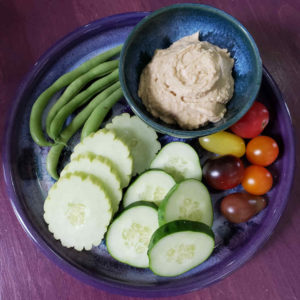Hummus needs little introduction today. Twenty years ago, most Americans didn’t know it even existed. Nowadays, it’s quite well known. That’s largely due to the success of the Sabra brand and PepsiCo’s marketing. Now, over a quarter of U.S. households buy hummus regularly. If you belong to one of those households, and you have a food processor, you should know that you can make it yourself super easily. It’s less expensive, better for you because it has no preservatives added, and you can season it any way you like.
The Process
This is the process. Grab all of the ingredients. Dump them all in the food processor. Turn on the food processor and let it run for a full 2 or 3 minutes. If you’ve ever tried making hummus at home and thought the texture was grainy compared to store bought hummus, it’s simply that you didn’t let the food processor do its thing for long enough.
The Ingredients
Obviously, chickpeas (or garbanzo beans if you like) are the main ingredient in hummus. But, potentially surprisingly, the water in which the chickpeas soak in their can is another great ingredient. Chickpea water, known as aquafaba, has become a key ingredient to modern vegan cooking where it replaces eggs and/or dairy in things like meringue, mayonnaise, mousse and ice “cream”. In hummus, it replaces olive oil, and it leads to a silky, creamy texture.
After chickpeas, tahini is the next most important ingredient in hummus. It is made of, simply, ground sesame seeds. It’s a key ingredient in many Middle-Eastern and Mediterranean dishes. Most grocery stores carry it, but you may not have a clue where to look. Just remember, it’s ground seeds. If it originated in the U.S., we’d have named it “sesame butter.” You can usually find it in the same section of the grocery store as peanut butter and almond butter.
Seasonings
Lemon, garlic, cumin and salt are the traditional seasonings for hummus. But, as you’ve seen all the flavor options for hummus in your grocery store, you know that you have a lot of options. Before you try making any exotic concoctions, I recommend sticking with the traditional seasonings to get a handle on your preferred level of spice. I specify one teaspoon of cumin per batch (made with one can of chickpeas). This is what we use in our house, which is a compromise between me (who would use more) and my wife (who prefers less). Once you have the level of flavorings down, you can replace a fraction of the cumin with other dry spices. A favorite in our house is ½ teaspoon of cumin and ½ teaspoon of Aleppo pepper. But, instead of Aleppo pepper, you could use chili powder, paprika (hot or sweet, smoked or not), or powdered chipotle pepper. Each of these chili varieties will bring their own unique nuances. Spice blends like English style curry powder or garam masala or za’atar are all options. I also like coriander or fresh cilantro leaves. If you like Kalamata olives, they work great in hummus. When I use them, I blend the hummus up well before I add 6 or 8 of them. I then blend further, stopping when the olives have been chopped to small chunks.

Quick and Easy Hummus
Equipment
- Food processor.
Ingredients
- 1 can chickpeas/garbanzo beans (15 ounces) (water reserved)
- ½ cup reserved liquid (aquafaba)
- 4 oz tahini
- 1 tsp salt
- 1 tsp cumin see note
- 2 tbsp lemon juice fresh squeezed
- 1 clove garlic
Instructions
- Combine all ingredients in a food processor. Turn on the food processor and let it go for a full 2 or 3 minutes. The longer it runs, the smoother the hummus will be. Taste test. If needed, adjust seasoning and blend a little bit more.

